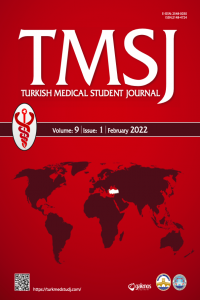PARTIAL NEPHRECTOMY OF A HORSESHOE KIDNEY WITH RENAL-CELL CARCINOMA AND CHOLECYSTECTOMY: A CASE REPORT
PARTIAL NEPHRECTOMY OF A HORSESHOE KIDNEY WITH RENAL-CELL CARCINOMA AND CHOLECYSTECTOMY: A CASE REPORT
Horseshoe kidney, nephrectomy, cholecystectomy,
___
- 1. Schiappacasse G, Aguirre J, Soffia P et al. CT findings of the main pathological conditions associated with horseshoe kidneys. Br J Ra- diol 2015;88(1045):20140456.
- 2. Kirkpatrick JJ, Leslie SW. Horseshoe Kidney. [Updated 2020 Aug 12]. In: StatPearls [Internet]. Treasure Island (FL): StatPearls Pub- lishing; 2020 Jan-. Available from: URL: https://www.ncbi.nlm.nih. gov/books/NBK431105/.
- 3. Natsis K, Piagkou M, Skotsimara A et al. Horseshoe kidney: a re- view of anatomy and pathology. Surg Radiol Anat 2014;36(6):517– 26.
- 4. Glenn JF. Analysis of 51 patients with horseshoe kidney. N Engl Med 1959;261:684–7.
- 5. Mesrobian HJ, Kelalis PP, Hrabovsky E et al. Wilms tumor in horseshoe kidneys: a report from the National Wilms Tumor Study. J Urol 1985;133:1002-3.
- 6. Bhandarkar KP, Kittur DH, Patil SV et al. Horseshoe kidney and associated anomalies: single institutional review of 20 cases. Afr J Paediatr Surg 2018;15(2):104-7.
- 7. Şeker KG, Şam E, Şahin S et al. Partial nephrectomy in horse- shoe kidney: primary carcinoid tumor. Arch Ital Urol Androl 2017;89(4):316-8.
- 8. Tkocz M, Kupajski M. Tumour in horseshoe kidney - different surgical treatment shown in five example cases. Contemp Oncol 2012;16(3):254-7.
- 9. Hohenfellner M, Schultz-Lampel D, Lampel A et al. Tumor in horseshoe kidney: clinical implications and review of embryogene- sis. J Urol 1992;147:1098–102.
- 10. Rubio Briones J, Regalado Pareja R, Martin FS et al. Incidence of tumoural pathology horseshoe kidneys. Eur Urol 1998;33:175–9. 11. Justo-Janeiro JM, Orozco EP, Reyes FJ et al. Transplantation of a horseshoe kidney from a living donor: case report, long term out- come and donor safety. Int J Surg Case Rep 2015;15:21-5.
- ISSN: 2148-4724
- Başlangıç: 2014
- Yayıncı: Trakya Üniversitesi
Elif CENGİZ, Fevzi Oktay ŞİŞMAN, Beliz KOÇYİĞİT, Mehmet Gürkan ARIKAN, Tevfik AKTOZ
THE FOURTH HORSEMAN OF 21ST CENTURY: COVID-19 PANDEMIC
İnci KADRİBEY, Fatih Erkan AKAY
MYOCARDIAL INFARCTION DIAGNOSIS AND CARDIAC TROPONINS
Berra KURTOĞLU, Burcu ERKILIÇ, Dilay Yağmur GÜRSEL, Gülsüm ARSLAN, Ogün BACAKSIZOĞLU, Pınar ALTUNDAL, Selin KARA, Yasemin ARDIÇOĞLU
THE EFFECT OF 5-FU AND RUXOLITINIB ON MITOCHONDRIAL APOPTOSIS IN GLIOBLASTOMA U87 CELL LINE
Gonca AKSU, Oğuzhan DOĞANLAR, Zeynep Banu DOĞANLAR
PATHOPHYSIOLOGY, CLINICAL FEATURES AND TREATMENT OF MICROVASCULAR ANGINA: A REVIEW
Hasan Selçuk ÖZKAN, Meral KAYIKÇIOĞLU
DISTANCE EDUCATION IN MEDICAL SCHOOLS: THE EXPERIENCE AND OPINIONS OF ACADEMICIANS AND STUDENTS
Hilal Sena ÇİFCİBAŞI, Berkay KEF, Irmak İrem ÖZYİĞİT, Sezin SAYIN, Aslı GÖZTEPE, Selis Gülseven GÜVEN, Serkan ATICI
INVESTIGATION OF THE PARAMETERS THAT MAY PREDICT HEMODIALYSIS FREQUENCY
Gökhan KIRAL, Alperen Taha CERTEL, Irmak İrem ÖZYİĞİT, Begüm SÖYLEYİCİ, Güray AYGÜN, Cenk GÖKALP
JUVENILE POLYP FROM SYMPTOM TO DIAGNOSIS AND THE ROLE OF ULTRASONOGRAPHY: A CASE REPORT
